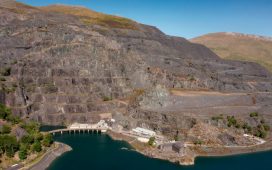There are two big tensions in how, and how quickly, the UK gets to net zero. One was the main focus of Rishi Sunak’s speech last week in which the phasing out of sales of new petrol and diesel vehicles was delayed and gas boilers got a semi-reprieve. But the other aspect, only briefly referenced, deserves more attention: it is the reform of planning rules to allow the UK to build new electricity infrastructure, including hated pylons, at twice the pace we usually manage.
For a prime minister who says “consent” is “the only realistic path to net zero”, there is potential for more trouble. Net zero involves doubling the UK’s use of electricity, which plainly requires more kit, but not everybody wants to live near a new high-voltage transmission line suspended on 50-metre stilts. It is hard to see how the government’s target of decarbonising the power network by 2035 (a target that survived last week’s bonfire of deadlines) can be met without upsetting a few local interests.
The relevant passage in the speech came after the one about how we will be saved from the menace of seven recycling bins, so may have been lost in the laughter. Here’s what Sunak said: “The chancellor and energy security secretary will shortly bring forward comprehensive new reforms to energy infrastructure. We’ll set out the UK’s first ever spatial plan for that infrastructure to give industry certainty and every community a say.”
At one level a “spatial plan” – a description of where to site the new pylons, cables and connectors – is a technical exercise in how to hook up offshore wind turbines, solar farms and new nuclear reactors to the grid and ensure electricity gets to places of high demand. The rewiring challenge is so huge because so much of the new renewables power is coming from Scotland and the east, whereas the grid was built in the era of centrally located coal stations. Some of the new infrastructure will be hard to miss.
Try the proposed 114-mile transmission line from Norwich to Tilbury to get power from windfarms in the North Sea to users in the south-east of England. It will mainly comprise overhead lines on pylons (cheaper than putting them underground) and will run through the East Anglian countryside. It won’t reach statutory planning consultation until next year but is pencilled in as “fully operational” by 2031. Local protests are up and running.
Then consider the scale of what is being planned nationally. “In Great Britain, around four times as much new transmission network will be needed in the next seven years as was built since 1990,” said Nick Winser, the new electricity commissioner in his report to government last month.
It has to happen so quickly for several reasons. First, there’s already a queue of projects waiting to be connected to the grid – enough to generate more than half of our future electricity needs, Sunak said. Second, the planning nightmare is having to pay renewable generators to stand idle because the system can’t handle their output; such “annual constraint costs” could rise from £500m-£1bn in 2022 to £2bn-£4bn a year by about 2030, warned Winser. Third, the 2035 deadline looms, which is why Winser was tasked with finding a way to deliver major power projects in seven years rather than the usual 14.
“We’ll speed up planning for the most nationally significant projects,” said Sunak, echoing Winser’s remarks about how national policy statements on energy “are badly out of date”. Translation: central government will have to be more heavy-handed in overruling local objections, and may have to legislate to that effect. Headline-grabbing ideas about giving “generous” lump-sum payments to communities near new power lines are just the warmup. On their own, they are unlikely to reconcile the twin ambitions of “certainty” for companies and “a say” for communities.
In the background, one can hear grumbles from officials who see the likes of TenneT, a large Dutch and German grid operator, placing massive multiyear orders in the capacity-constrained market for high-voltage cables. They wonder if our own operators – National Grid, Scottish Power and SSE – should be doing the same now. In the other direction, executives argue that the government first needs to give itself new planning powers and then demonstrate that it is prepared to use them.
after newsletter promotion
All the above would also apply to an incoming Labour government, of course – probably more so because Labour wants to complete decarbonisation of the power grid by 2030. In the face of scepticism about the credibility of that deadline, party insiders speak about bringing a “vaccine taskforce mentality” to a national effort and possibly using government procurement to secure the cables. But, as with the government, streamlining planning approvals is seen as critical. It is the next net zero battleground.











